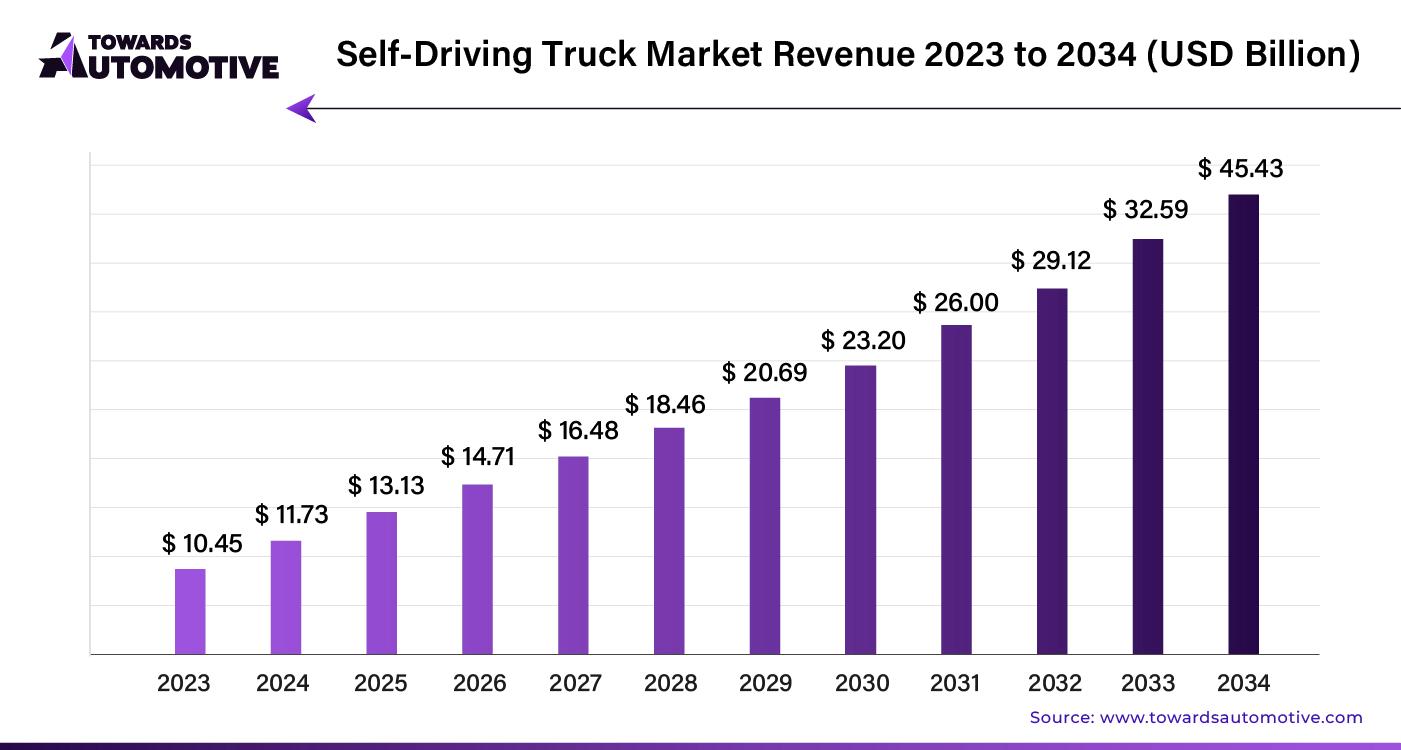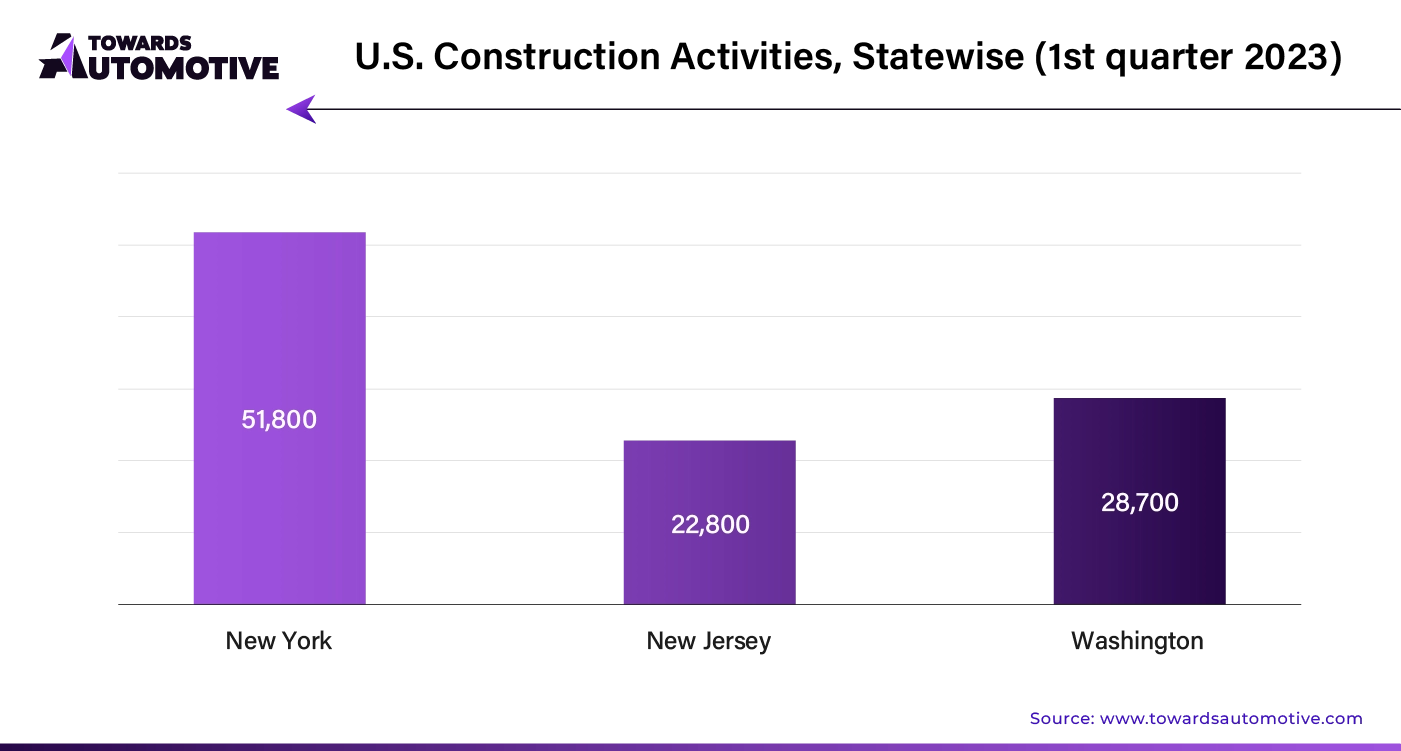April 2025
The global self-driving truck market size is calculated at USD 11.73 billion in 2024 and is expected to be worth USD 45.43 billion by 2034, expanding at a CAGR of 12.13% from 2024 to 2034.
Unlock Infinite Advantages: Subscribe to Annual Membership
The self-driving truck market is rapidly emerging as a transformative force in the logistics and transportation industries, driven by advancements in autonomous vehicle technology and the growing need for efficient, cost-effective freight solutions. Self-driving trucks are equipped with advanced sensors, AI-driven systems, and real-time data analytics that enable them to operate with minimal or no human intervention. These trucks promise to revolutionize supply chains by reducing labor costs, minimizing human error, and improving fuel efficiency through optimized route planning.
The global rise in e-commerce and the demand for faster, more reliable delivery services have accelerated the adoption of self-driving trucks, particularly in long-haul and commercial applications. In addition, the trucking industry faces a growing shortage of drivers, making automation an attractive solution for addressing workforce challenges. Governments and regulatory bodies are also starting to create frameworks for autonomous vehicle testing and deployment, further supporting the market's growth.
As technology continues to evolve, self-driving trucks are expected to improve safety, reduce operational costs, and increase the overall efficiency of transportation networks, positioning them as a key player in the future of logistics.
Artificial intelligence (AI) plays a central role in the self-driving truck market, enabling autonomous trucks to navigate complex road environments and perform tasks traditionally managed by human drivers. AI systems process data from various sensors, including LiDAR, radar, and cameras, to interpret the truck’s surroundings in real-time. This allows autonomous trucks to detect obstacles, make decisions about speed, lane changes, and braking, and adjust to dynamic traffic conditions, all while ensuring safety and efficiency.
Machine learning, a subset of AI, is crucial for enabling self-driving trucks to learn from vast amounts of data, improving their decision-making capabilities over time. AI-powered algorithms can optimize route planning, reducing fuel consumption and delivery times by choosing the most efficient paths. Furthermore, AI facilitates predictive maintenance by analyzing data on vehicle performance, identifying potential mechanical issues before they lead to breakdowns, which helps reduce operational downtime and costs.
In addition, AI supports fleet management, allowing companies to monitor and control multiple autonomous trucks simultaneously. As AI continues to evolve, it will enhance the safety, reliability, and efficiency of self-driving trucks, playing a pivotal role in shaping the future of logistics and freight transportation.
The rise in construction activities is a significant driver of growth in the self-driving truck market. As construction projects continue to increase globally, particularly in infrastructure development and urban expansion, there is a growing demand for efficient and cost-effective transportation of materials. Self-driving trucks offer a solution by reducing labor costs and improving operational efficiency in material delivery and logistics for construction sites. These trucks, equipped with autonomous navigation systems, can operate continuously without the limitations of human drivers, allowing for faster and more reliable material transportation, even in remote or hazardous areas.
Additionally, the construction industry faces a shortage of skilled labor, particularly truck drivers, which has made autonomous trucks an appealing alternative to traditional transportation methods. By optimizing delivery routes and improving fuel efficiency, self-driving trucks also help reduce overall project costs and contribute to timely project completion. As construction activities continue to rise, especially in large-scale infrastructure projects, the demand for autonomous trucking solutions is expected to grow, positioning the self-driving truck market as a key player in the future of construction logistics.

The self-driving truck market faces several restraints, including high development and implementation costs due to the advanced technology required for autonomous systems. Regulatory challenges also hinder growth, as varying safety standards and legal frameworks across regions create barriers to widespread adoption. Additionally, the need for robust infrastructure, such as reliable 5G networks and smart roads, limits deployment in some areas, making the market's expansion dependent on technological advancements and regulatory support.
Improved safety features are creating significant opportunities in the self-driving truck market by addressing one of the key concerns surrounding autonomous vehicles: safety. With advancements in sensor technologies such as LiDAR, radar, and high-resolution cameras, self-driving trucks are becoming increasingly adept at detecting obstacles, pedestrians, and other vehicles, thereby reducing the likelihood of accidents. These technologies enable trucks to navigate complex road environments, react swiftly to unexpected situations, and maintain safe distances from other vehicles, all without human intervention.
Additionally, the integration of vehicle-to-everything (V2X) communication systems allow self-driving trucks to interact with surrounding infrastructure and other vehicles. This improves coordination on the road, reducing congestion and accident risks, especially in high-traffic or hazardous conditions. These safety improvements not only enhance trust in autonomous technology but also lower insurance premiums and liability costs for fleet operators, making self-driving trucks a more financially attractive option.
By ensuring greater safety, these features open the door for wider regulatory approval and public acceptance, accelerating the deployment of autonomous trucks. As safety technology continues to evolve, it creates a pathway for the self-driving truck market to expand, offering safer, more reliable transportation solutions for industries such as logistics, construction, and freight delivery.
In January 2024, Aeva Technologies announced that the company gained a deal worth US$ 1 billion. Under this deal, Aeva Technologies will supply Lidar sensor to Dailmer Trucks for use in self-driving trucks.
The software segment held the largest share of the market. The software segment plays a pivotal role in driving the growth of the self-driving truck market by providing the essential algorithms and systems that enable autonomous functionality. Advanced software platforms are responsible for processing vast amounts of data collected by sensors, cameras, and radar systems to guide self-driving trucks safely through various environments. These platforms use artificial intelligence (AI), machine learning, and real-time data analytics to make split-second decisions, such as adjusting speed, changing lanes, and avoiding obstacles.
As self-driving technology evolves, the demand for sophisticated software solutions continues to grow. This includes software for route optimization, which reduces fuel consumption and delivery times, and predictive maintenance systems, which monitor truck performance to prevent breakdowns and minimize downtime. Software advancements in simulation and virtual testing also enable manufacturers to refine autonomous driving systems without relying solely on real-world testing, accelerating development and reducing costs.
Additionally, software integration with cloud platforms facilitates better fleet management, allowing logistics companies to track and control multiple autonomous trucks in real time. The rapid development and deployment of such software solutions are critical to the expansion of the self-driving truck market, as they enhance vehicle safety, operational efficiency, and scalability.
The mining segment led the market. Mining operations are significantly driving the growth of the self-driving truck market by creating a high demand for autonomous vehicles that can handle the unique challenges of the industry. Mining environments often involve harsh conditions, such as extreme temperatures, dust, and rugged terrain, which make traditional transportation methods costly and complex. Self-driving trucks offer a solution by operating continuously without the limitations of human fatigue, improving efficiency and productivity in transporting ore and materials within mining sites.
Autonomous trucks equipped with advanced sensors and AI technologies can navigate these challenging environments with precision, reducing the risk of accidents and enhancing safety. They are capable of performing repetitive tasks, such as hauling materials from excavation sites to processing facilities, with consistent performance, which helps in optimizing logistics and reducing operational costs. Additionally, self-driving trucks can be integrated into automated mining fleets, coordinating with other machinery and systems to streamline operations and increase overall throughput.
The adoption of self-driving trucks in mining is also driven by the industry's need to address labor shortages and improve working conditions. By automating the transportation of materials, mining companies can mitigate the impact of workforce challenges and enhance operational efficiency. As these technologies continue to advance, they are expected to play an increasingly important role in transforming mining operations, fueling further growth in the self-driving truck market.
The electric transmission segment dominated the market. Electric transmission is driving the growth of the self-driving truck market by offering a synergy between autonomous technology and sustainable transportation. Electric drivetrains provide several benefits that complement the advancement of self-driving trucks, including reduced operating costs, lower emissions, and quieter operation. For self-driving trucks, which are designed to optimize routes and enhance efficiency, integrating electric transmission can further lower energy costs and improve overall performance.
Electric transmission systems are inherently compatible with the software and control systems used in autonomous trucks. They allow for precise control of power delivery, which enhances the performance of self-driving algorithms that manage acceleration, braking, and regenerative energy. This synergy leads to more efficient and smoother operation, which is crucial for autonomous trucks navigating various terrains and traffic conditions.
Moreover, the growing emphasis on sustainability and stricter emissions regulations are accelerating the adoption of electric drivetrains in self-driving trucks. The combination of electric power and autonomous technology meets environmental standards and addresses the need for cleaner transportation solutions. As battery technology advances, providing longer ranges and faster charging, the integration of electric transmission with self-driving trucks is expected to become increasingly common, driving growth in both markets and contributing to a more sustainable and efficient logistics industry.
Asia Pacific dominated the self-driving truck market. In Asia Pacific, the rapid urbanization and infrastructure development, e-commerce boom, and environmental regulations are pivotal in driving the growth of the self-driving truck market. As urban areas expand and infrastructure projects proliferate, there is an increasing need for efficient and scalable logistics solutions. Self-driving trucks can alleviate congestion and streamline transportation networks, enhancing the flow of goods in rapidly developing cities and industrial hubs. Concurrently, the explosive growth of e-commerce amplifies demand for swift and reliable delivery services, making autonomous trucks an ideal solution for meeting high delivery volumes and reducing operational costs.
Additionally, stringent environmental regulations across the region are accelerating the adoption of eco-friendly technologies. Governments are promoting the use of electric and hybrid self-driving trucks to lower emissions and meet sustainability goals. These trucks not only align with regulatory requirements but also contribute to improved air quality and reduced carbon footprints. Together, these factors create a robust environment for the self-driving truck market's expansion in Asia Pacific, positioning autonomous vehicles as a critical component of the region's evolving transportation and logistics landscape.

LAMEA is expected to grow with a significant CAGR during the forecast period. In the LAMEA region, economic growth and trade, technological advancements, and the pursuit of safety and efficiency are key drivers of the self-driving truck market. As economic activities and trade volumes increase across Latin America, the Middle East, and Africa, there is a growing need for efficient and scalable logistics solutions. Self-driving trucks address this demand by optimizing freight operations and reducing transportation costs, making them an attractive option for businesses seeking to enhance supply chain performance amidst economic growth.
Technological advancements play a crucial role in making autonomous trucks more viable and effective. Innovations in artificial intelligence, machine learning, and sensor technologies are advancing the capabilities of self-driving trucks, enabling them to navigate complex environments and perform reliably. These technological improvements are driving the adoption of autonomous vehicles, as they offer enhanced performance and integration with existing logistics systems.
Additionally, the focus on safety and efficiency further propels the market. Autonomous trucks are designed to reduce accident rates and improve operational efficiency through precise navigation and real-time data analysis. By mitigating human error and optimizing route management, these trucks contribute to safer roads and more effective logistics operations, aligning with the region’s growing emphasis on modernizing transportation infrastructure and improving overall safety standards.
By Component
By Application
By Level of Automation
By Propulsion Type
By Region
April 2025
April 2025
April 2025
April 2025
We offer automotive expertise for market projections and customizable research, adaptable to diverse strategic approaches.
Contact Us